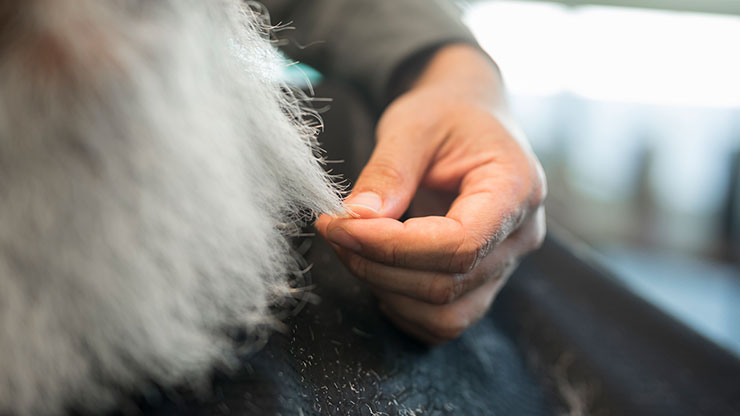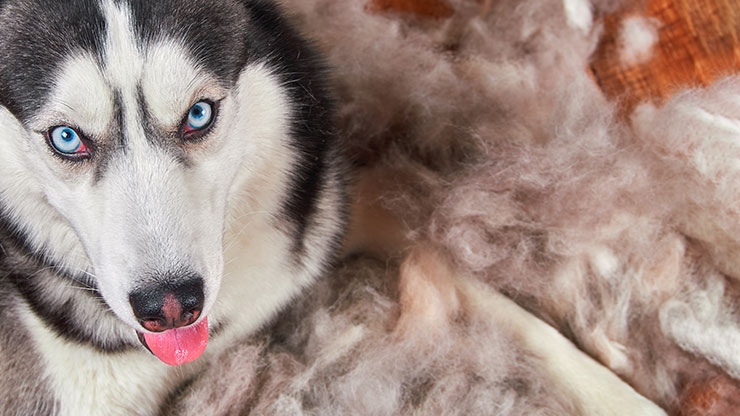
Heaviest Shedding Breeds
1. Akita
There are two different types of Akitas: the American and the Japanese breeds. Both are dignified and independent thinkers. They nobly keep watch of all they survey and deem “their” property. Fiercely loyal and courageous, they make excellent companions and watchdogs.
Both Akita breeds have similar hair that sheds a lot! Their skin is well-fitted and never saggy or loose. It should allow for some flexibility without obscuring the outline of the dog. They have harsh, straight, weather-resistance outer coats with soft, dense undercoats. The hair on the head, ears, and lower legs is shorter, while the hair on the withers and rump is slightly longer (approximately two inches). The hair on the tail is the longest and most profuse, but never with a profuse ruff or feathering.
These dogs blow out their entire coat twice a year, for the winter and summer months specifically, but drop hair year-round. That is why it takes regular grooming to maintain their coat and keep that hair under control - especially if you have an Akita that stays indoors! It is recommended not to shave their coat because it can protect against the sun.
The best types of brushes for maintaining an Akita’s hair include slicker brushes, bristle brushes, pinhead brushes, rake brushes, and rubber brushes or gloves. Use a slicker brush to remove loose hairs, a rake brush for the undercoat, a comb for remaining loose hairs and missed mats or tangles, and a bristle brush to smooth everything out.
2. Chow Chow
The Chow Chow is an intelligent and independent breed. They are known for their calm reserve and discernment between friend and foe. Due to their protective and independent nature, socialization and obedience training should be implemented to establish boundaries and discipline early. They are mostly quiet, yet they make excellent guard dogs since they bark when something is truly amiss.
The Chow Chow comes in two coat varieties: the rough coat and the smooth coat. Both types are double-coated. For the rough-coat variety, their hair is shorter on the face and ears and dense, plush, coarse, and stands completely off the body. The length of the outer coat will vary markedly from medium to medium-long in length. The undercoat is short, thick, dense, and soft. The coat on the neck and chest is abundant, forming a ruff, and these dogs have well-plumed tails. The back of the legs is fringed, forming breeching. For the smooth-coat variety, the coat throughout is short and off-standing, never flat. The outer coat is not much longer than the undercoat, and there is no distinguishable fringing, feathering, or plumed tail.
The Chow Chow is a seasonal shedder and blows their coats like other double-coated dog breeds. But this breed also drops hair in clumps instead of scattered hairs. The smooth-coated type is easier to maintain, but both require consistent grooming.
“The best brush for a Chow Chow is a slicker brush, a pin brush effective at detangling fur. Make sure to brush all the way down to the skin. This will let your dog’s skin breathe and evenly distribute natural skin oils for a healthy coat. You may want to use a steel comb in tandem with the slicker brush to ensure you get every tangle,” according to “Do Chow Chows Shed?”.

3. German Shepherd
The German Shepherd breed is strong-nerved, fearless, self-assured, self-composed, confident, watchful, poised, and alert when necessary. They should never be timid, shy, nervous, anxious, or overly fearful (including fear-aggressive). The breed is physically capable of speed, power, agility, and endurance and is self-aware enough to know their capabilities and limits. This offers them a great deal of confidence.
The German Shepherd comes in two coat varieties: standard smooth and long coats. The smooth coat has a very dense, harsh, close-fitting outer coat and a soft, dense undercoat. It is short on the head, face, ears, and front of the legs, paws, and toes. The hair is slightly longer on the backside of the legs, forming moderate "trousers," and on the neck, forming a slight ruff. The long-coat variety has dense, soft, long guard hairs, forming fringe on ears, tail, and legs, forming bushy trousers on the backside of haunches. The hair is short on the head, face, the front side of legs, paws, and toes and longer on the coat, nearly forming a mane.
The German Shepherd breed is year-round shedders and blows their coats twice a year. They are not hypoallergenic dogs. Cleaning up and maintaining the fur on a German Shepherd will be a daily task that owners must be willing to put in the time to complete. Daily brushing, keeping the dog inside, and getting a German Shepherd fixed may help eliminate some shedding issues, but they will still shed to some degree.
The best tools for maintaining a German Shepherd’s hair are a double-sided brush, de-matting tool, undercoat de-shedding tool, and good shampoo and conditioner. According to World of Dogs, “The best grooming tools for German Shepherds are the FURminator range, as they are designed for them and effectively reduce shedding. These include a brush for daily use, a de-matting tool for removing matted hair, and an undercoat de-shedding tool.”
4. Great Pyrenees
This flock guardian is bred to exude a calm and assuring demeanor, not to frighten the flocks they are employed to protect. The Great Pyrenees are observant and discerning, capable of quickly telling a herd from a predator, a friend from a foe. They are developed to bond strongly with their flocks and families at a young age. Due to the intensity with which they bond, socialization should be employed on individuals who accompany their families outside the property; otherwise, they may become overly protective homebodies. They typically behave as gentle giants unless a threat is identified.
The Great Pyrenees comes in two coat varieties: smooth and long coats. The standard rough coat variety is well furnished with a dense, flat, long, supple, weather-proof outer coat, especially on the shoulders and back. Hair on the face, ears, topskull, and front of the legs is shorter. Longer on the neck, rump, and tail forming crest, frill, thick, fine, woolly trousers, and plumed tail may have a slight wave. The undercoat is thick.
Flat-coat variety: Sparser coats are sometimes found in the breed and are more suited for life in hot or humid climates. The coat is medium length, lies flatter, and is closer to the body than the standard coat. Longer hair can be found on the neck, forming a slight ruff and mane, on the backs of the legs and the underside of the tail, forming fringing.
These dogs are moderate shedders, with their heaviest season for shedding being in the spring. It is good to brush out their coat once a week. A slicker brush is one of the best for keeping up with a Great Pyrenees coat. Bathing them in de-shedding shampoo and feeding them a healthy diet will help with the shedding, but nothing will stop it altogether. So, if you plan on keeping this dog indoors, furniture covers are recommended, and seat covers for when the dog must be transported places.

5. Siberian Husky
The Siberian Husky is a true working dog with a strong instinct to move. This instinct should be both exercised and curbed with obedience training. Because of this, dogs of this breed have been bred and raised to work as a “team” for thousands of years. They tend to be excellent for multi-dog families, being alert, gentle, and friendly while lacking the possessive tendencies of other breeds.
The coat is a double coat with a straight, somewhat close-lying outer coat, usually medium in length. A dense, soft undercoat supports the outer coat. The tail is well-furred, forming a foxlike brush or natural tail. The coat is never long, rough, silky, or standing off from the body. According to Husky House: “All Siberian Huskies shed. Most Huskies will blow their undercoat twice a year (usually before a big season change). Some Huskies will only blow their undercoat once a year. Since Siberians shed constantly, bathing is minimal (as when they shed, the dirt also falls off). It is recommended to brush your Siberian constantly during the "blowing of their coat" and after at least once a week to control their shedding around your home.”
A slicker brush works great for a Siberian Husky’s coat. This brush will be rough enough to get out mats and get through their thick coats while also being great for areas like the face and stomach that are a little more sensitive.
Conclusion
We love dogs, and sometimes fur is just part of the package. In the case of the Akita, the Chow Chow, the German Shepherd, the Great Pyrenees, and the Siberian Husky, these breeds all have thick double coats that will continually shed throughout the year and at least twice heavily during seasonal changes. These coats are beautiful if kept maintained and are strong characteristics of each breed, but the upkeep will take time and could be costly if handed over to a groomer.
It may come as a surprise that even some short-coated breeds are known to be heavy shedders, although the length and amount of hair are much less. If you want to know if your furry friend is going to be a heavy shedder, DNA testing can help! Science can identify the genes responsible for heavy year-round and seasonal shedding, light shedding, and those in between!
Knowing the facts can help a family prepare for a fur-ever friend, especially knowing the grooming requirements! Check out some of our other blogs related to dog shedding information, like Grooming and Cleaning Tips for Living with a Heavy-Shedding Dog, or more general grooming information in our article Grooming Tips and Tricks for Your Pup!










